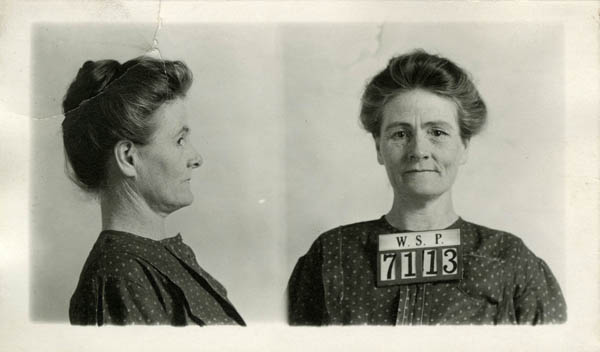10/14/15 – Starvation Heights
October 14, 2015I’ve never been a fan of Halloween. As a child I didn’t enjoy dressing up, so I gladly took my parents’ offer to buy one candy bar of my choosing to enjoy every October 31st instead of going trick-or-treating in Washington’s infamous drizzle. Growing up in the small, idyllic town of Port Orchard, Washington, the ghosts and goblins didn’t scare me. Instead, the true life story of Linda Hazzard, the pseudo doctor who starved her patients to death less than 18 miles from my childhood home, was what sent shivers up and down my spine.
Hazzard arrived in the Evergreen State in 1906 with a dream to establish a sanatorium. Taking advantage of a licensing loophole that allowed people without medical degrees to practice alternative medicine, Hazzard immediately began expounding her medical philosophy. Hazzard believed that all ailments, from toothaches to the flu, derived from “impure blood” brought on from “impaired digestion.” Her 1908 self-published book, Fasting for the Cure of Disease outlined her conviction that fasting allowed the digestive system to rest. However, Hazzard’s idea of “rest” was extreme. Her fasting regime entailed daily enemas that lasted hours and required twelve quarts of water. Hazzard also prescribed intense massages where she would pound her patients’ bodies. On top of everything else, Hazzard only allowed her patients to eat small servings of vegetable broth.
While unconventional, her methods weren’t altogether unheard of, and Hazzard attracted her fair share of patients. Over the course of two years, six of Hazzard’s patients died from her deadly therapy. One of those six was Daisey Maud Haglund, who at age 38 died after a 50-day fast at Hazzard’s direction. She left behind a three year old son, Ivar, who in adulthood would establish Seattle’s beloved Ivar’s seafood restaurants. The deaths at the hands of Hazzard did not go unnoticed, with The Seattle Daily Times publishing a headline the read “Woman ‘M.D.’ Kills Another Patient.” Despite the bad press, patients continued to subject themselves to Hazzard’s lethal fasting methods. Soon a pattern emerged. It became evident that Hazzard sought out wealthy patients whom she would enervate with her gruesome therapy. Through either delirium or fear, Hazzard would convince her patients to bequeath their entire estate to her and her equally swindling husband.
However, the tide changed for Hazzard when two rich English sisters, named Dorothea and Claire Williamson, enrolled in her fasting cure. After enduring the two months of intense fasting in a Seattle apartment, Hazzard transferred the sisters to her makeshift sanatorium in Olalla. Concerned for the well-being of Dorothea and Claire, the sisters’ nanny traveled to Olalla only to find a severely emaciated Dorothea who had incoherently relinquished her estate and guardianship to Hazzard. Eventually, Dorothea was reunited with her family, but only after they paid a ransom for her return. Fate was not so kind to Claire, who died of starvation prior to the nanny’s arrival.

A severely emaciated Dorothea Williamson before her rescue from Hazzard. Source.
After eating, and generally regaining her faculties, Dorothea paid to prosecute Hazzard in 1911. Incriminating testimony, a detailed paper trail, and blatant forgery (not to mention the death of two more patients as she awaited trial) resulted in a verdict of manslaughter. The Kitsap County jury stripped Hazzard of the ability to practice alternative medicine and sentenced her to hard labor at a Walla Walla penitentiary. In a bizarre turn of events, after only two years in prison the Washington state governor pardoned Hazzard. Still fasting frenzied, Hazzard moved to New Zealand to be near supporters, but returned to Olalla in 1920 and fulfilled her dream of building a sanitarium. However, after only three years, flames engulfed the institution and Hazzard was left only with her fasting beliefs, which eventually killed her.

Hazzard’s 1911 mug shots. Source.
In 2011, on the centennial of Hazzard’s 1911 arrest and conviction, approximately 300 people descended upon Olalla to tour “Starvation Heights,” the long used nickname for Hazzard’s notorious property. It was the last opportunity for fear junkies and spook seekers to catch a glimpse of the few remnants that remained of Hazzard’s sanatorium, as the current owners of the property planned to once and for all dismantle Starvation Heights.
Despite having been bulldozed, the story of Hazzard and Starvation Heights still terrifies me. And so, this Halloween, like so many before, I’ll stay inside, whip up a fall feast, and enjoy my one candy bar.
– Stephanie Milne-Lane
___________________________________________________________________________________________________
Sources:
Baurick, Tristan. “Olalla’s ‘Starvation Heights’ Still Causes Chills After a Century.” The Kitsap Sun, July 9, 2011, Updated Dec. 30, 2014.
Beck, Kathrine, “Hazzard, Linda Burfield (1867-1938): Fasting Proponent and Killer.” HistoryLink.org Essay 7955, Oct. 26, 2006.
Lovejoy, Bess. “The Doctor Who Starved Her Patients to Death.” Smithsonian.com, Oct. 28, 2014.